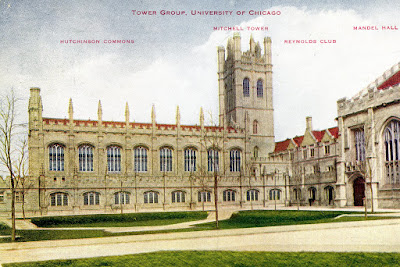Reminiscing on some well-travelled
campus haunts:
Hitchcock Hall is an unusual building, inside and out. Completed in 1902 as a men’s residence hall,
it has Gothic elements encased in prominent horizontal lines enclosing five
vertical sections, four stories each, connected only by cross corridors in the
basement and on the quad side a ground floor, unheated cloister. It was designed, writes campus historian Jay
Pridmore, as “a merger of Prairie School and Gothic Revival.” Very UChicago – cross-discipline
fertilization. How
many other Prairie-Gothic buildings can one name on the National Register of Historic Places?
 |
| Hitchcock Hall (Snell Hall in more traditional Gothic design is adjacent to the right) |
Hitchcock Hall is a place
where once upon a time, after yet another intense conversation around a greasy
table in the basement kitchen, someone would remark sardonically “well, another
raucous Saturday night at the U of C;” but also a place where, should anyone
try to leave such conversation, on the price of tea in China or carbon-carbon
double bonds, the plea “five more minutes” would invariably be heard.
Bartlett Gymnasium was a pretty neat, and historic, place. It once stood as the eastern part of the
Stagg Field complex, housing a big gym, offices for coaches, a large trophy
room with testaments of past Big Ten glories, and a locker room where attendant
Bill Dee would string a mean Hornet squash racket for a young college freshman. It was decorated with large hand-painted
murals and most notably over the entrance a large, multi-paneled stained glass
window depicting a scene from Ivanhoe “in which the knight is crowned for his
triumph in a legendary twelfth-century tournament” (Pridmore). Build of very
solid limestone in the Gothic style, of course, with the same turrets and
battlements found on Stagg Field.
A place where I learned the
game of squash, which I played there for many years, and the place where I
would interview the athletic coaches for my short-lived small sports column in
the student newspaper The Chicago Maroon. In the twenty-first century, upon completion on
the edge of campus of a larger athletic center with a faddish, futuristic-look,
the convenient and centrally-located Bartlett Gymnasium building was turned into
a cafeteria. My oh my. |
| Hutchinson Commons, Mitchell Tower, a sliver of the Reynolds Club, and a corner of Mandel Hall (L to R) |
 |
| Hutchinson Commons; Portraits Fill the Walls Now |
My thin wallet preferred the
adjacent C-Shop, where, if flush with a few extra dollars from the
latest advance on a loan, my pals and I ate many a greasy hamburger rather than
cooking up a pot of cheaper spaghetti or gnocchi. We were glad to have a late night dining option
on campus. It looks now to have been
converted into a healthy-food sandwich, granola, and muffin shop, with a full
line of organic juices. Times have
changed.
 |
| Cobb Gate (Incorrectly named on the postcard) |
Finally, for now, Cobb
Gate merits a mention. It is the
south entrance (on 57th Street) first to Hull Court, with its complex
of biology buildings, and then to the main quadrangles. Traversed innumerable times in a typical
undergraduate’s stint, it certainly is a sight, a passageway beneath a massive
limestone archway covered with a bevy of gargoyles and other grotesque creatures
glaring down on passers-by, a fair warning that the University of Chicago isn’t
for the faint of heart.












No comments:
Post a Comment